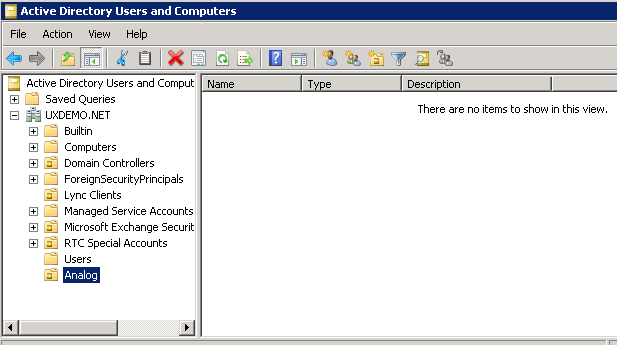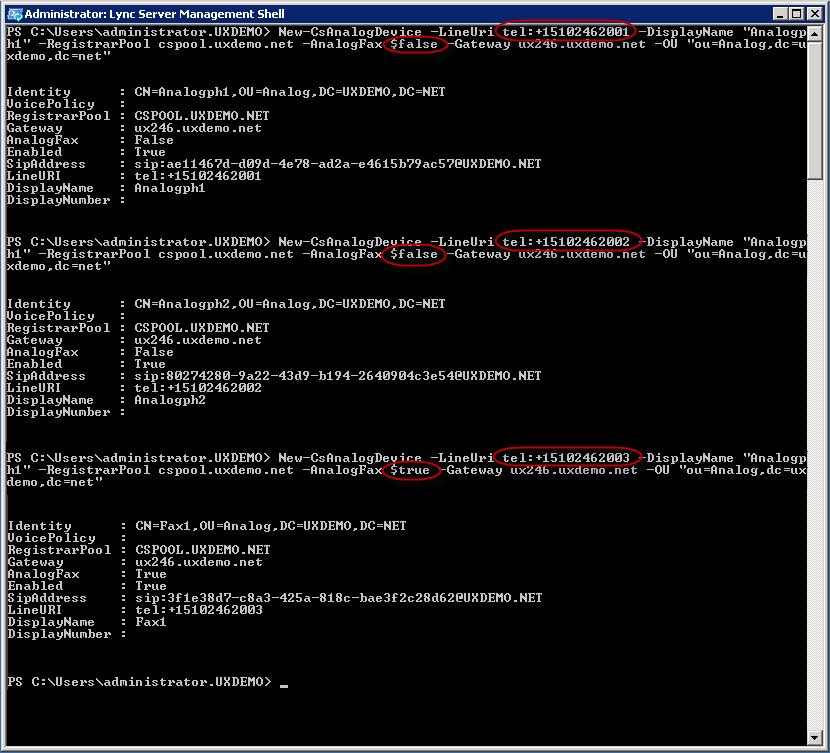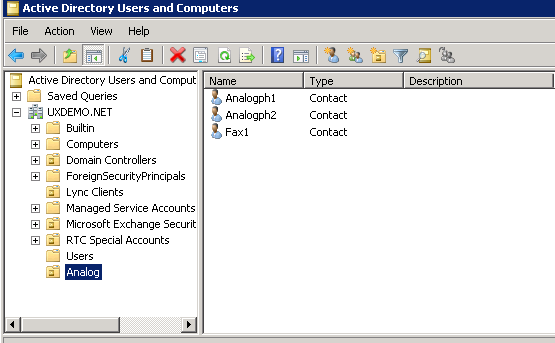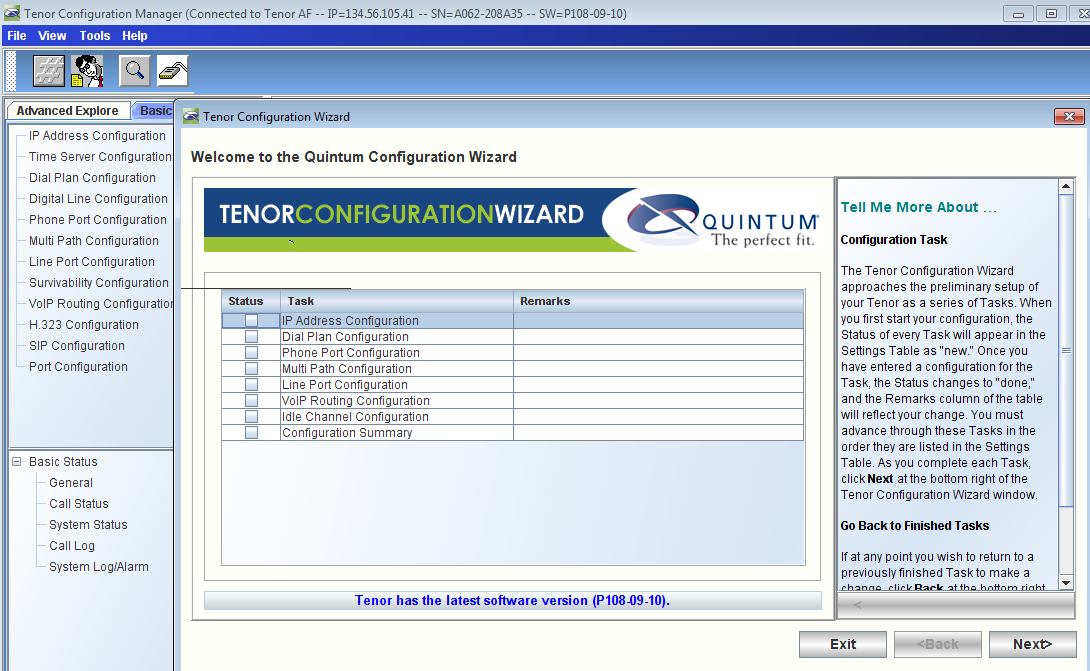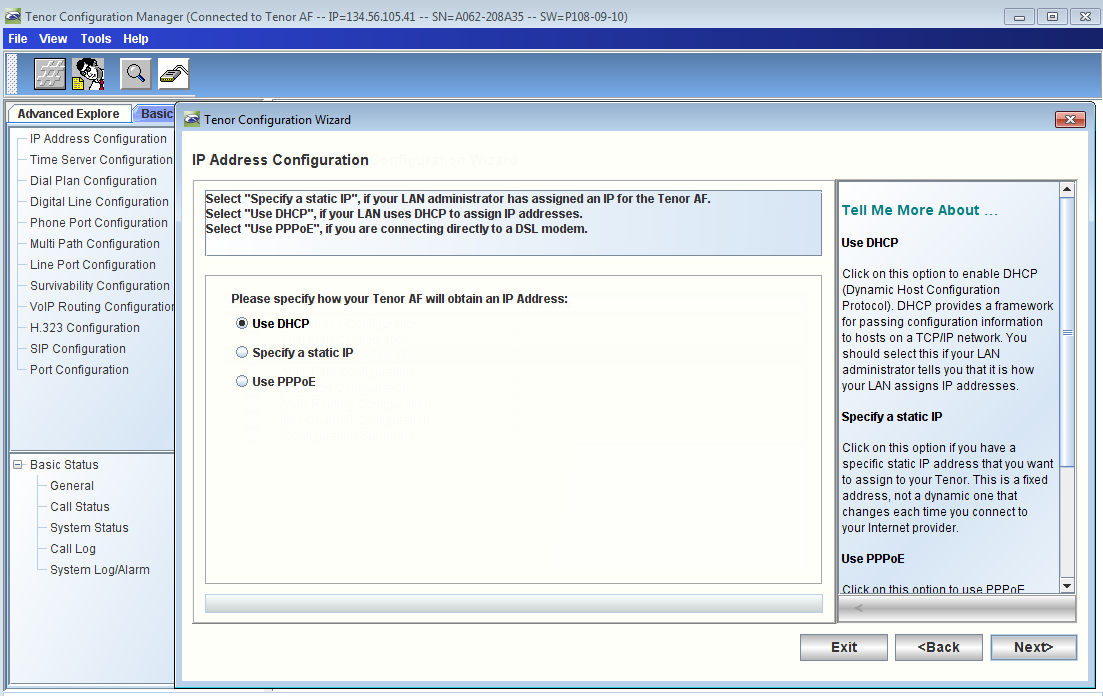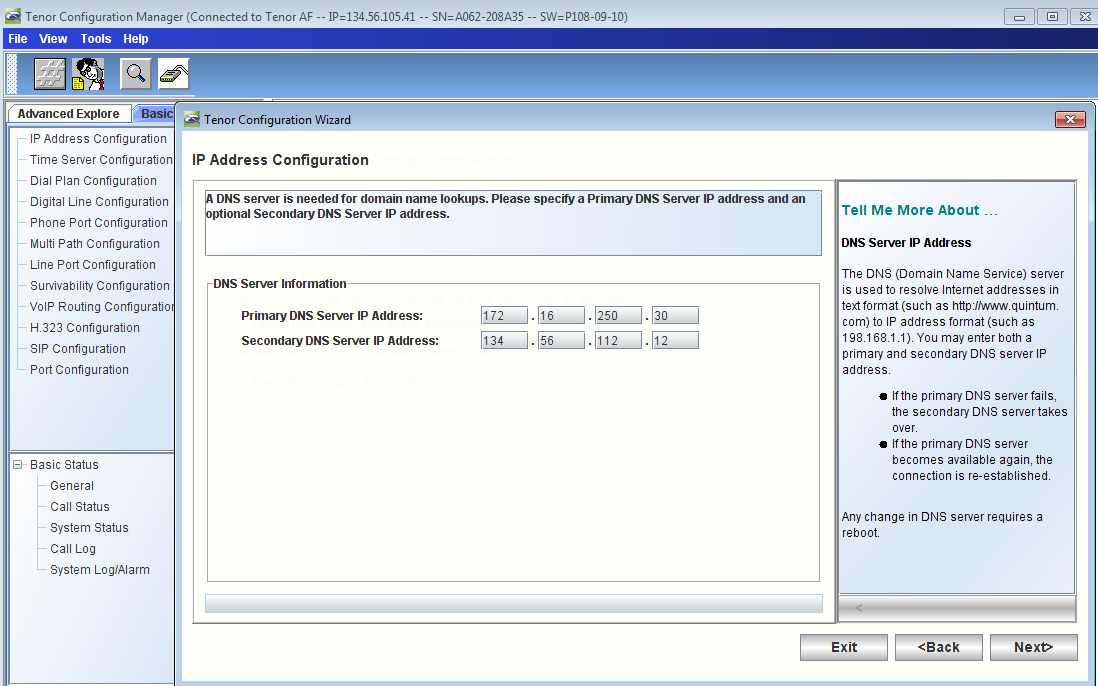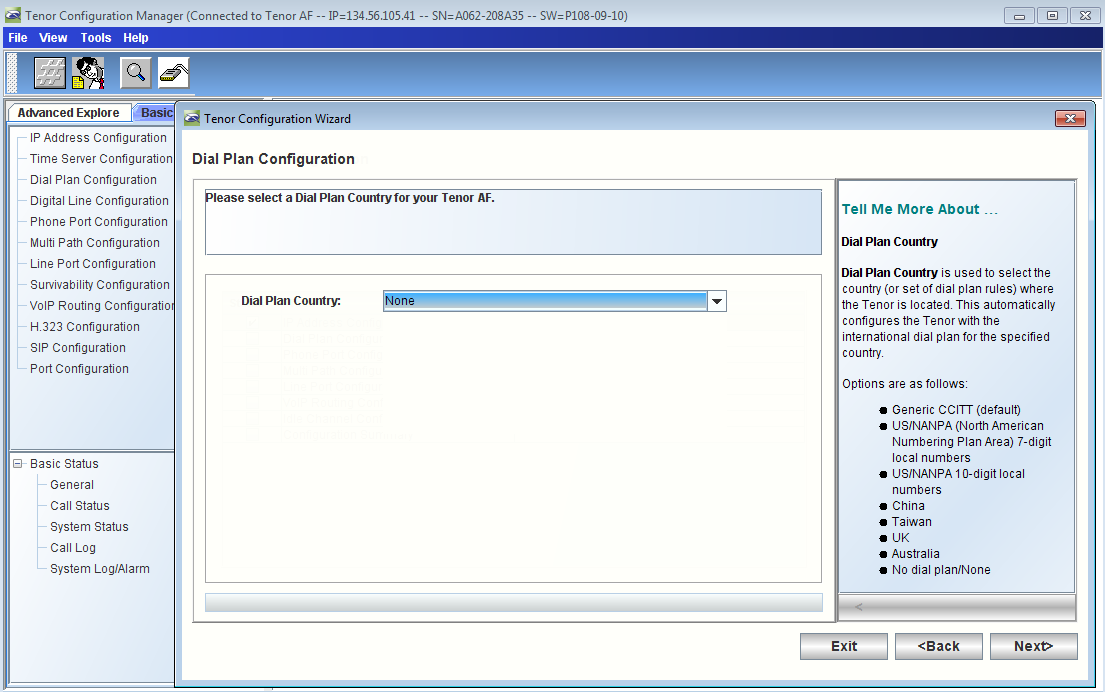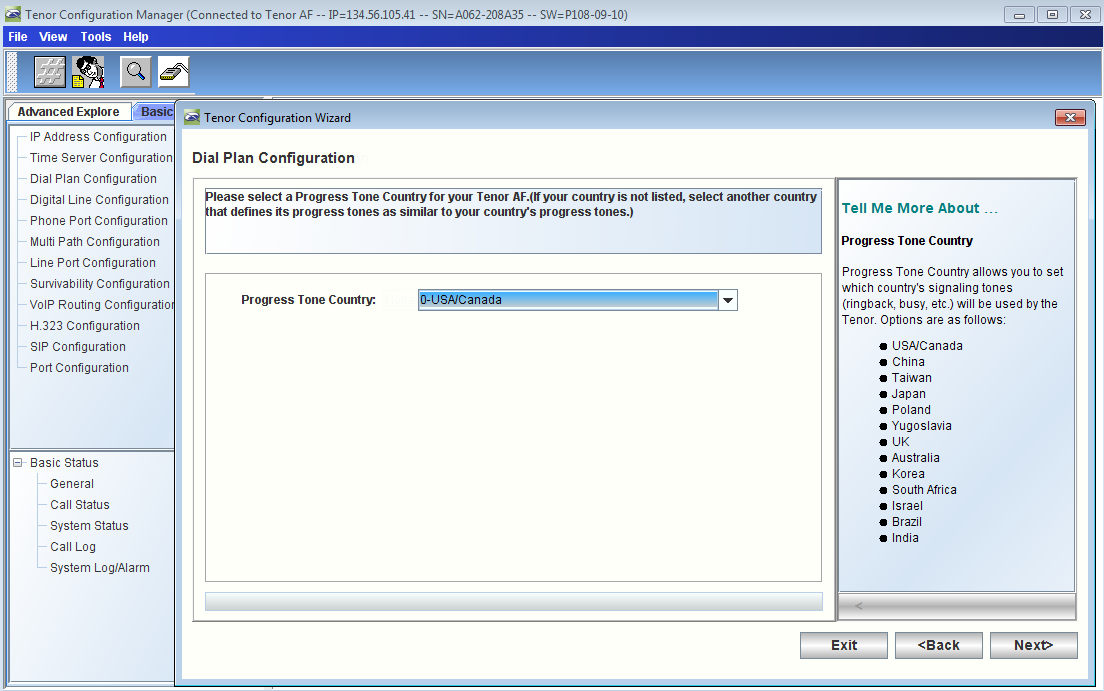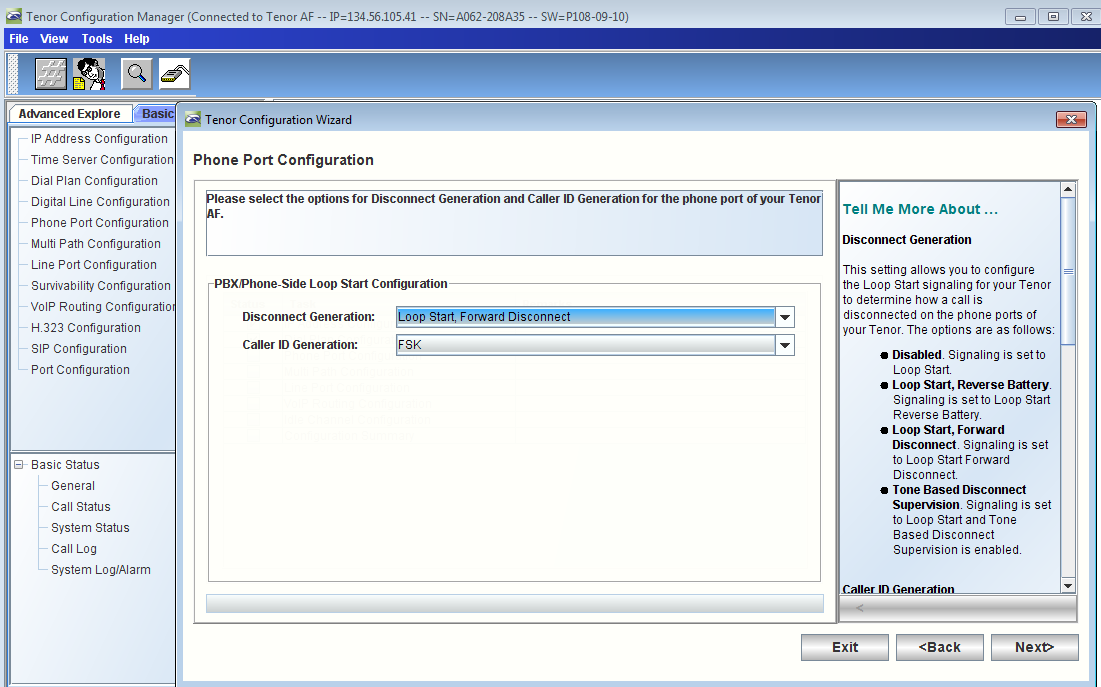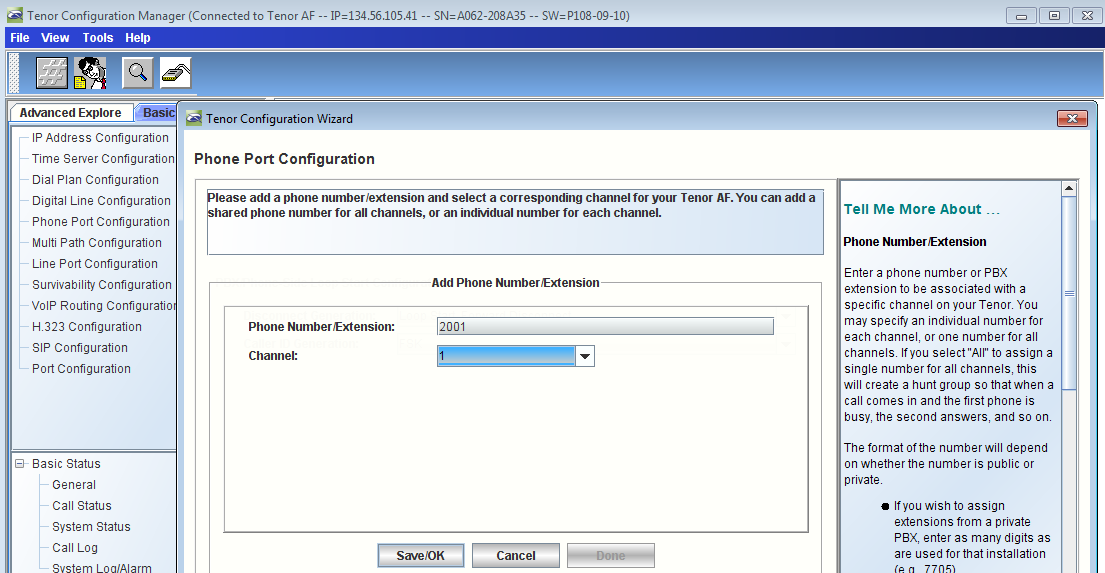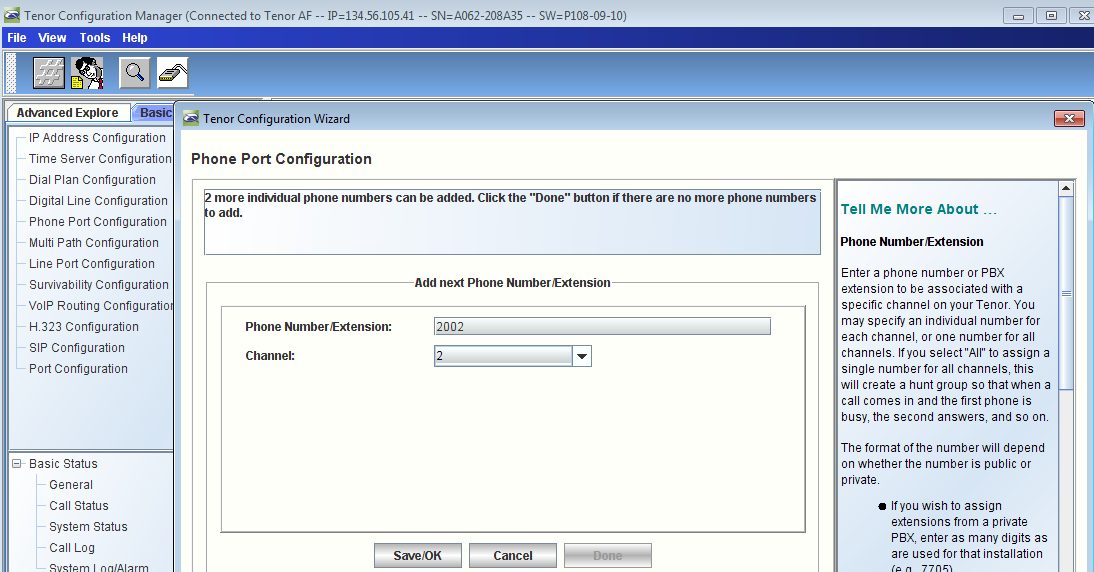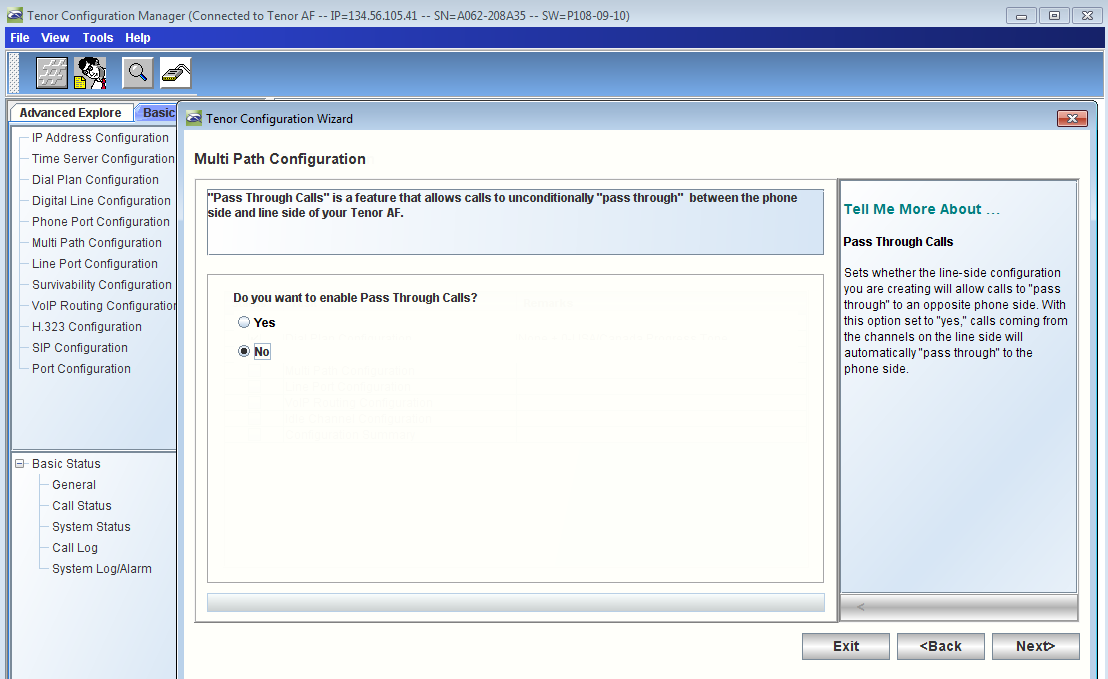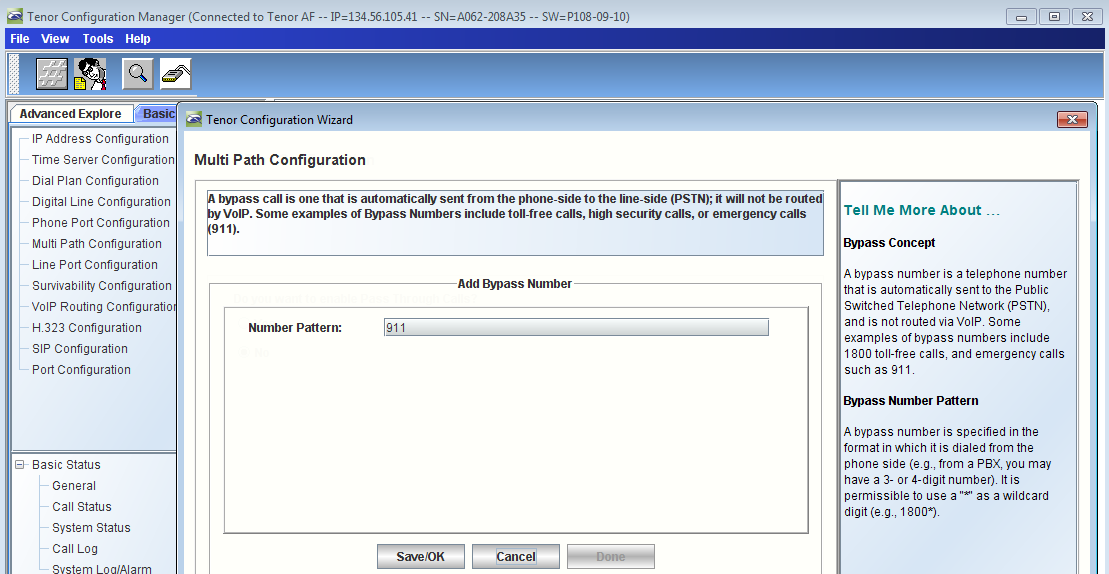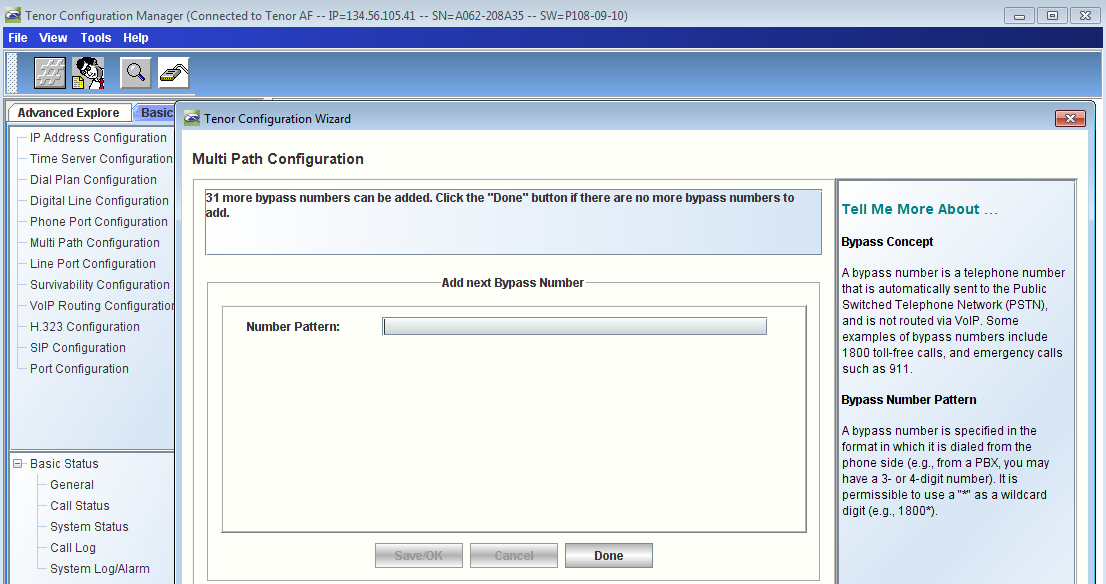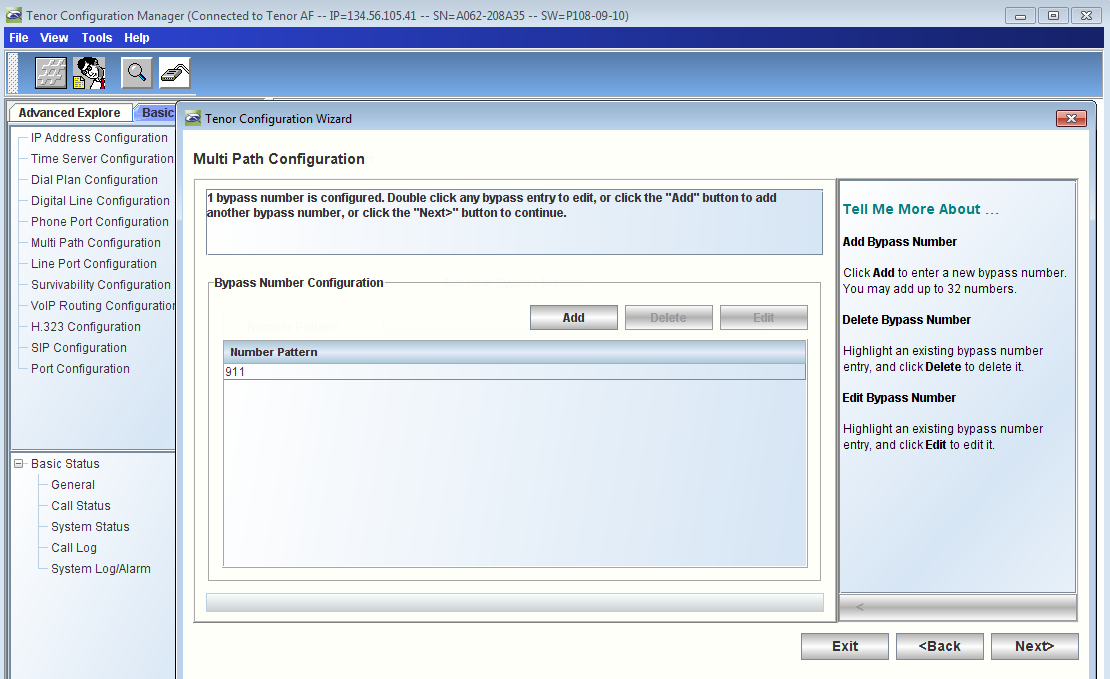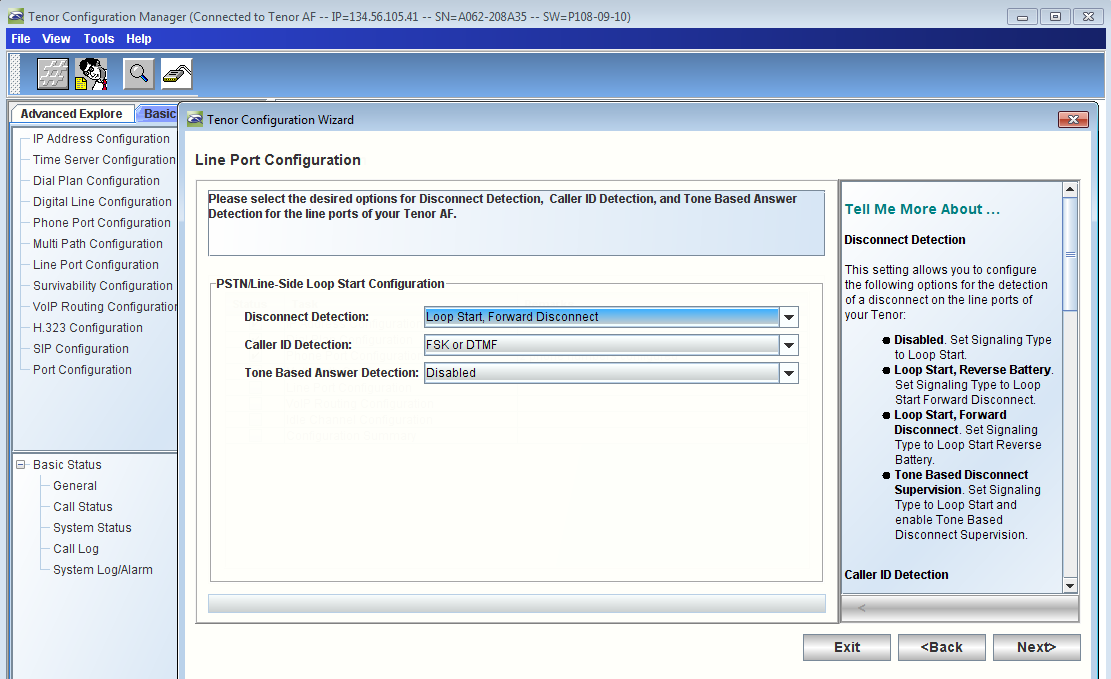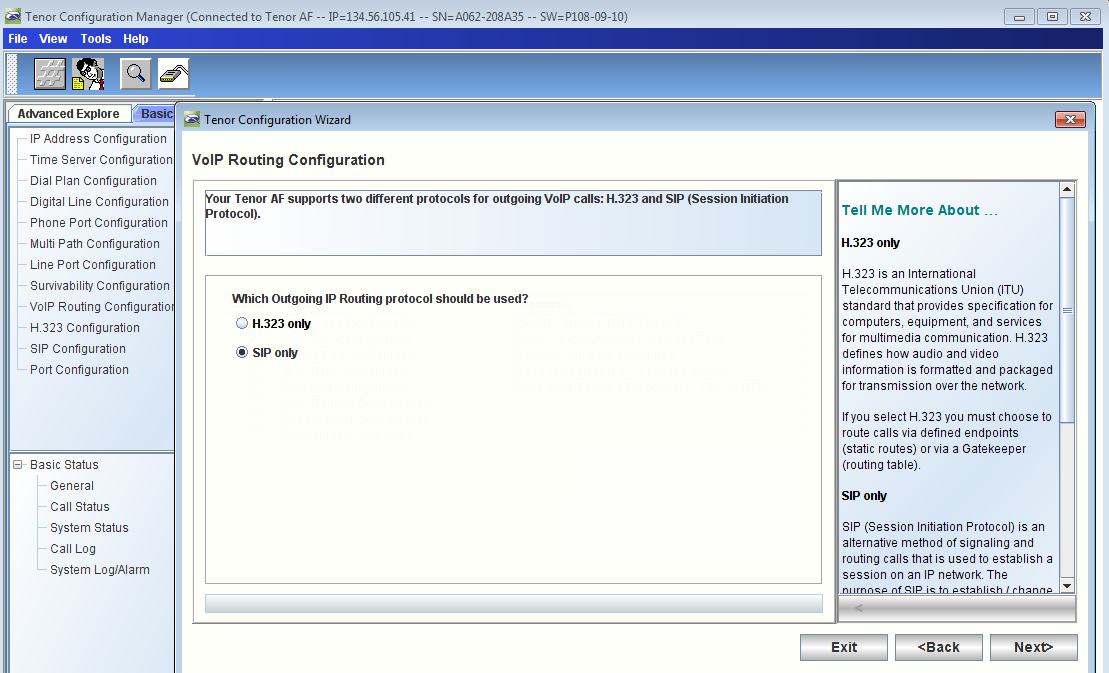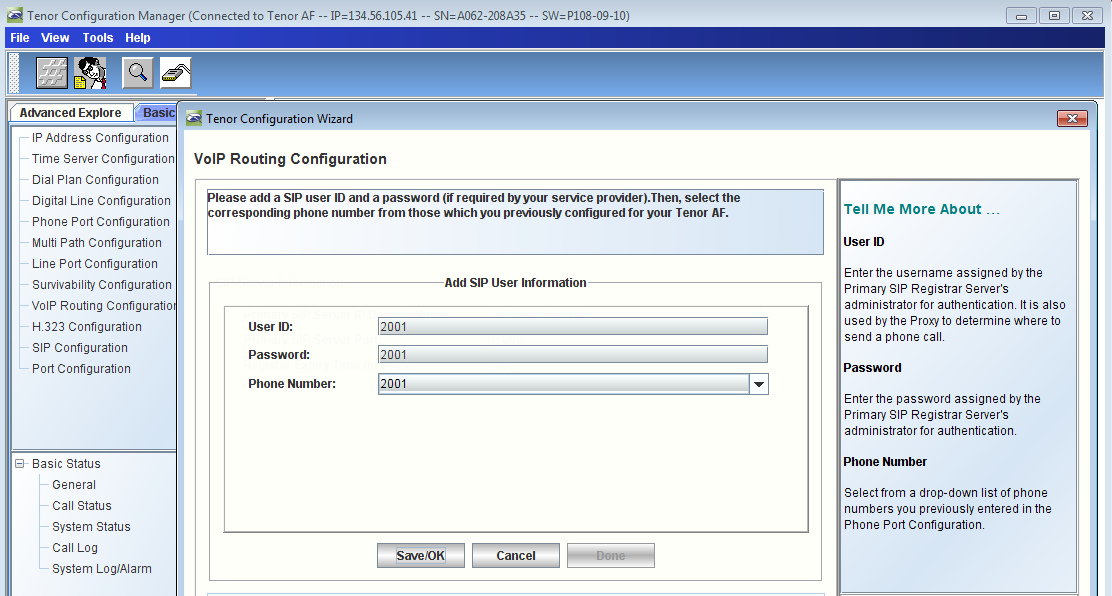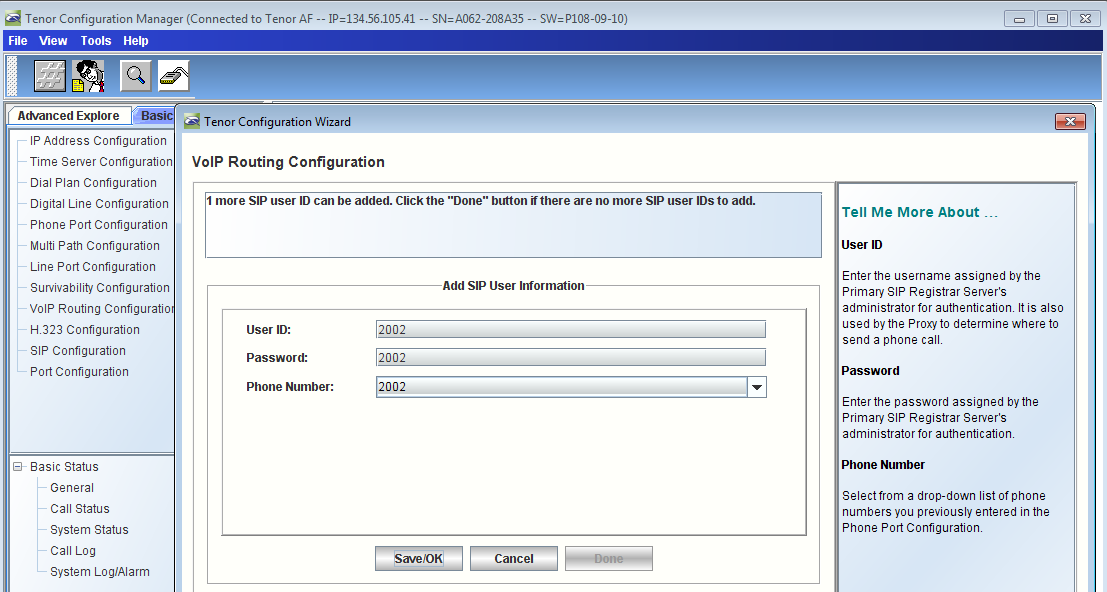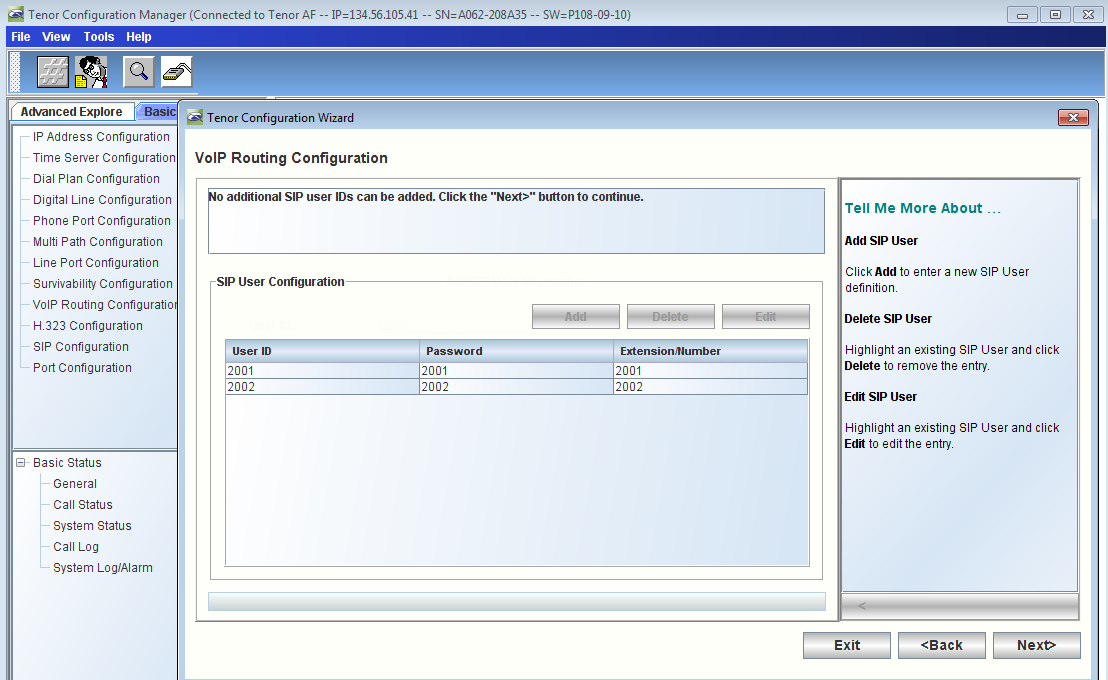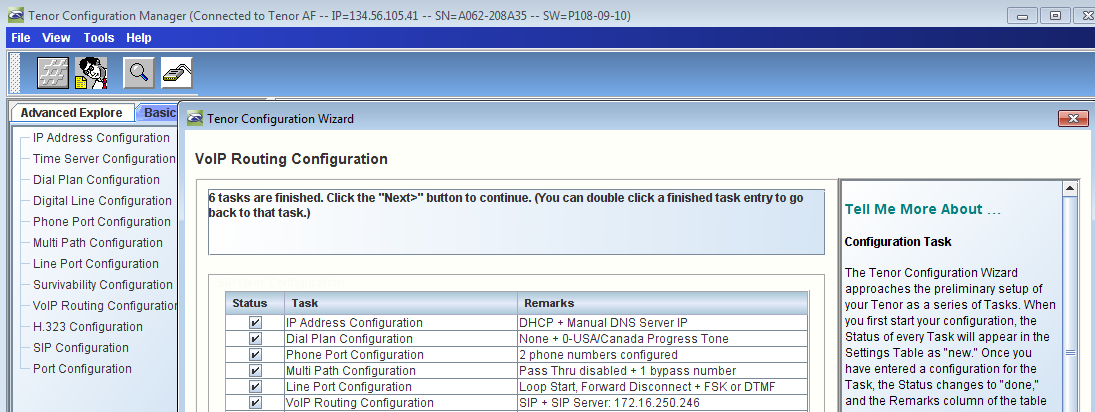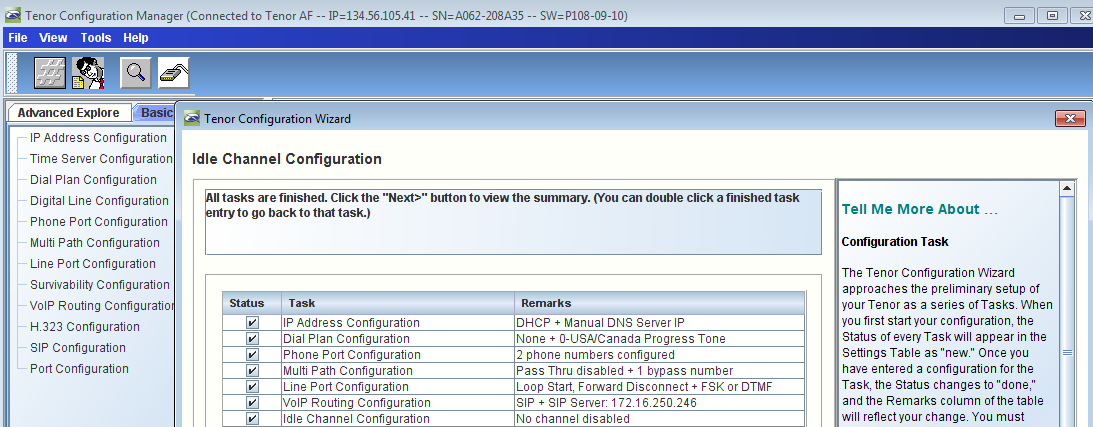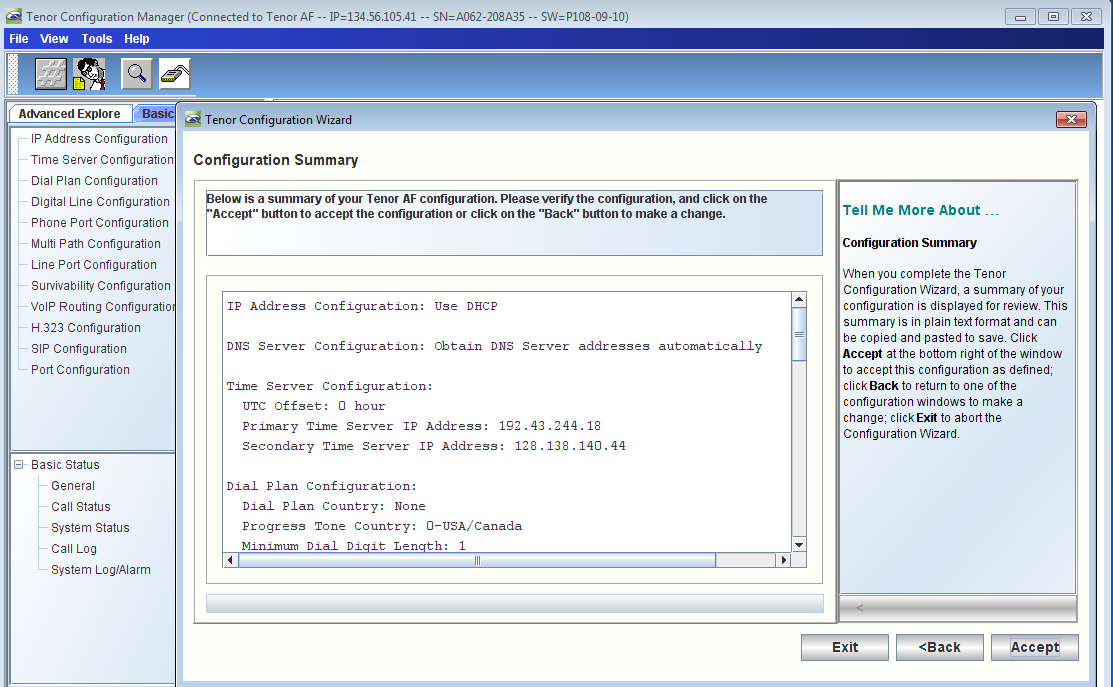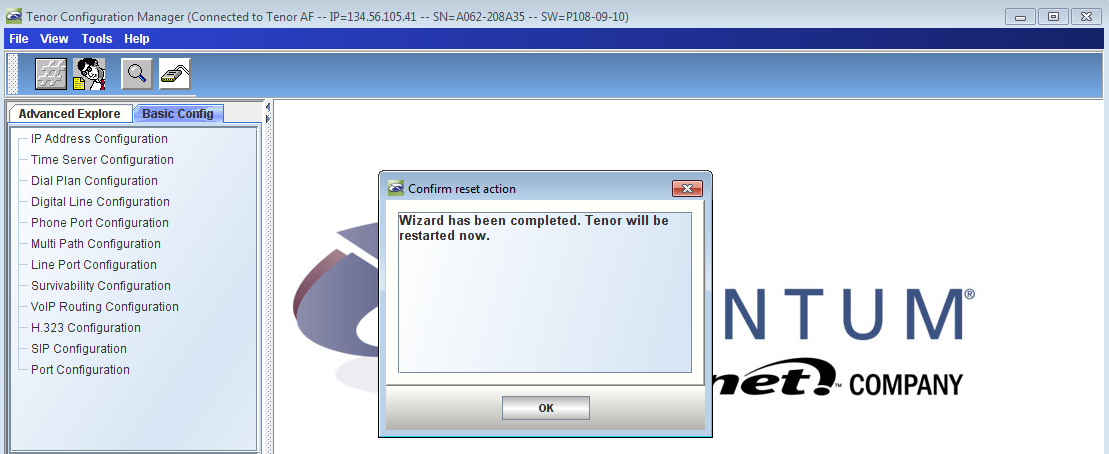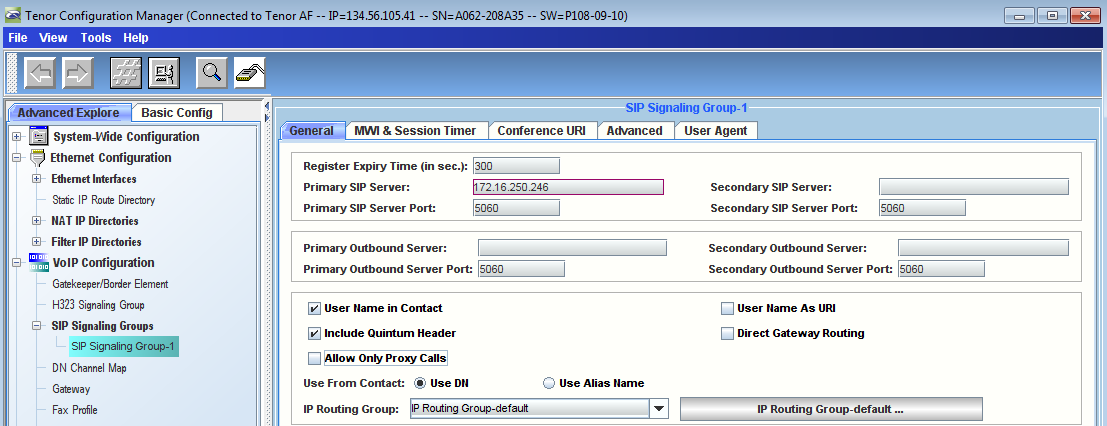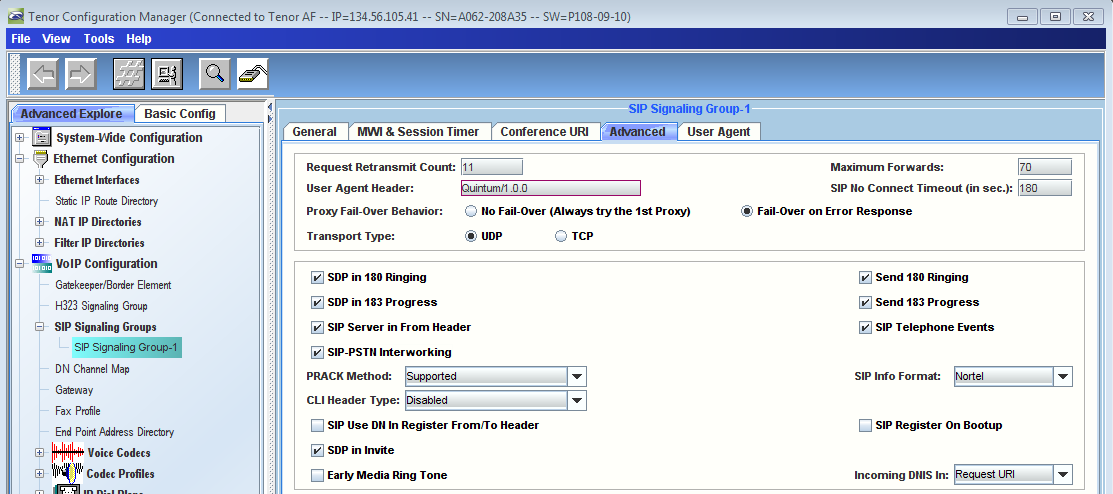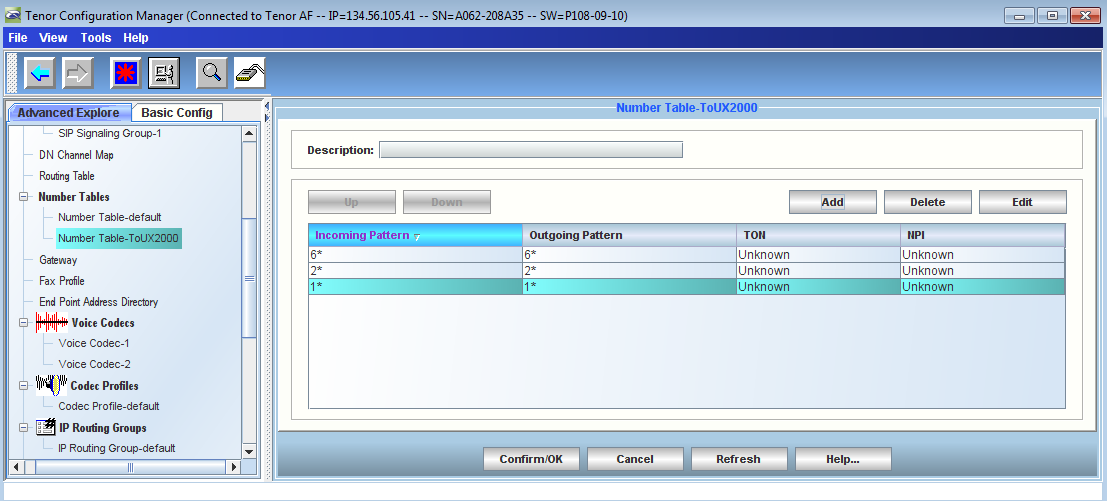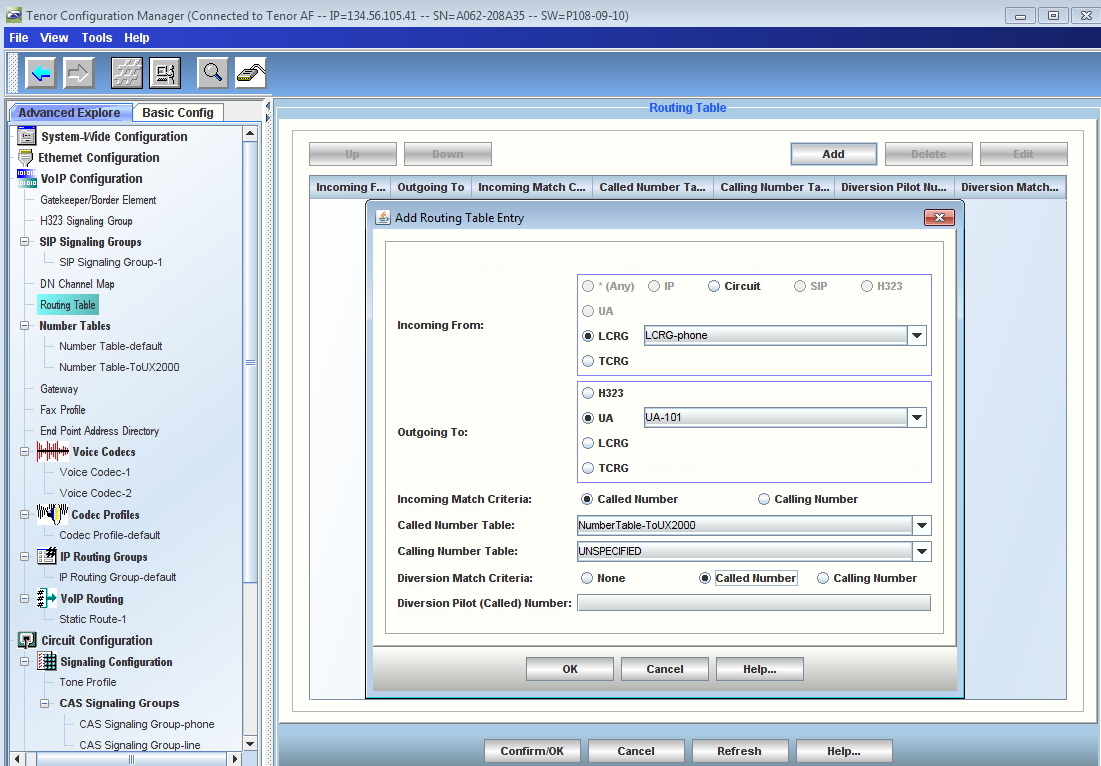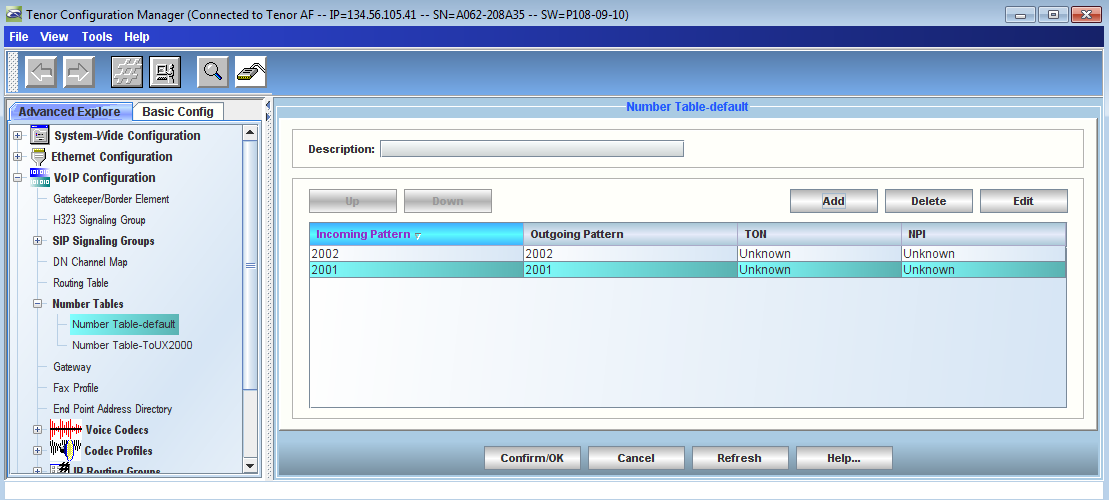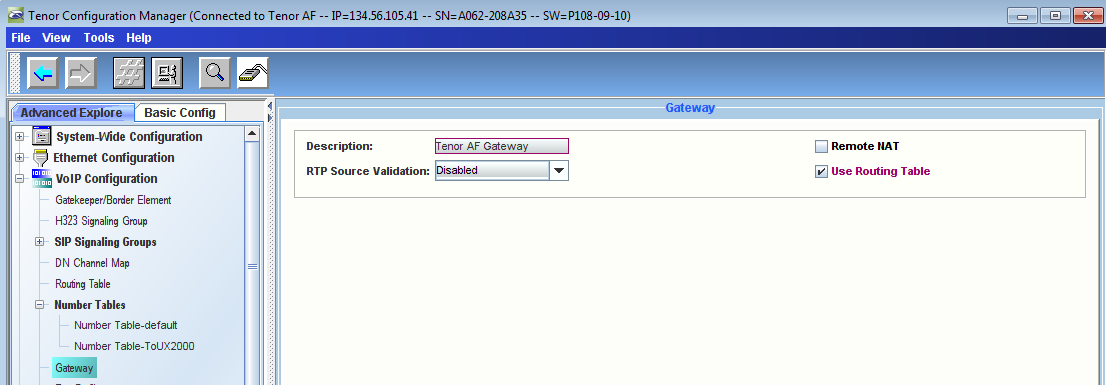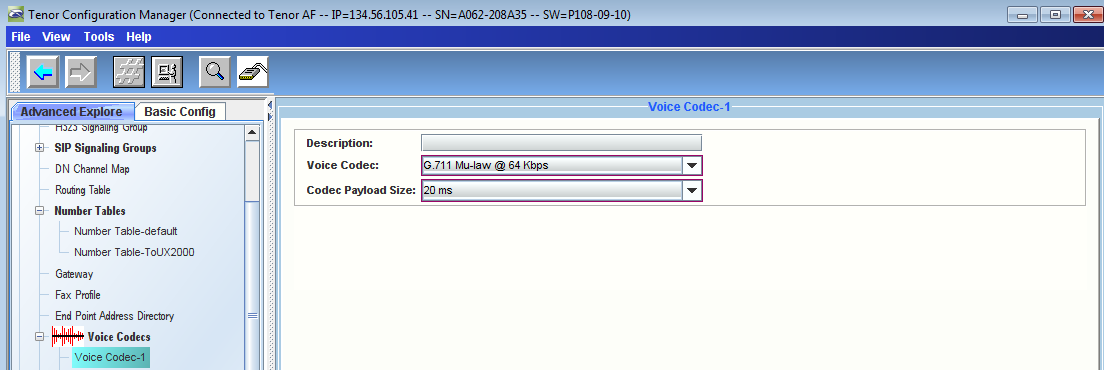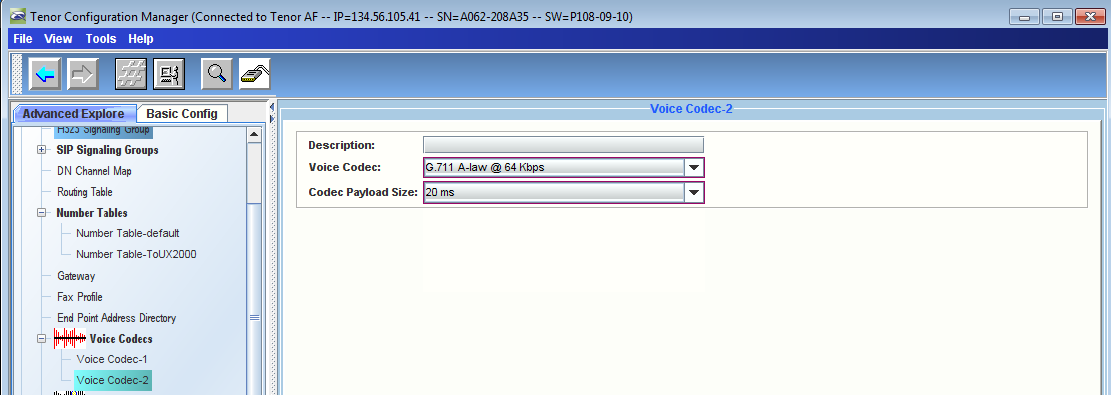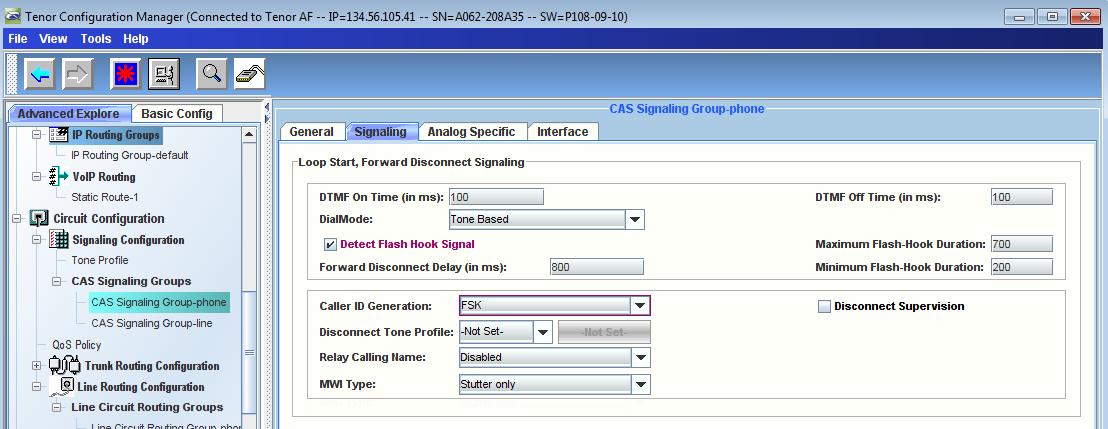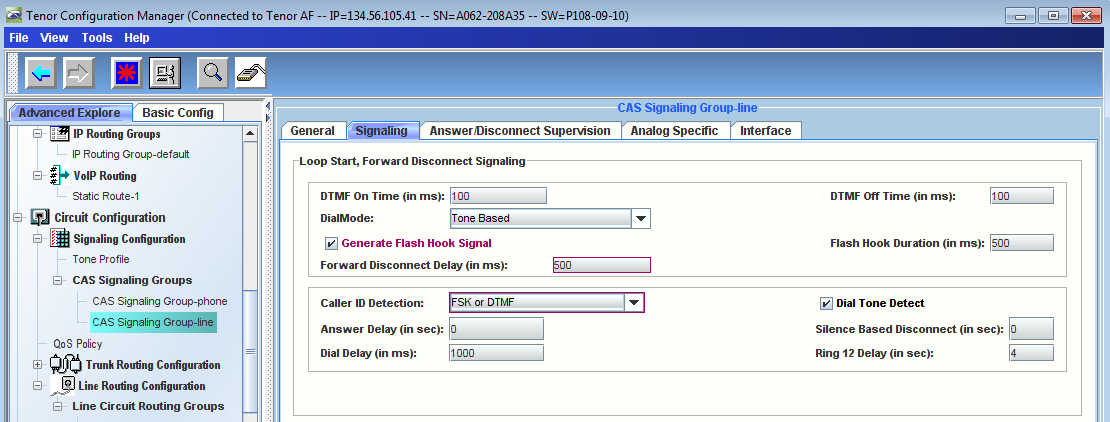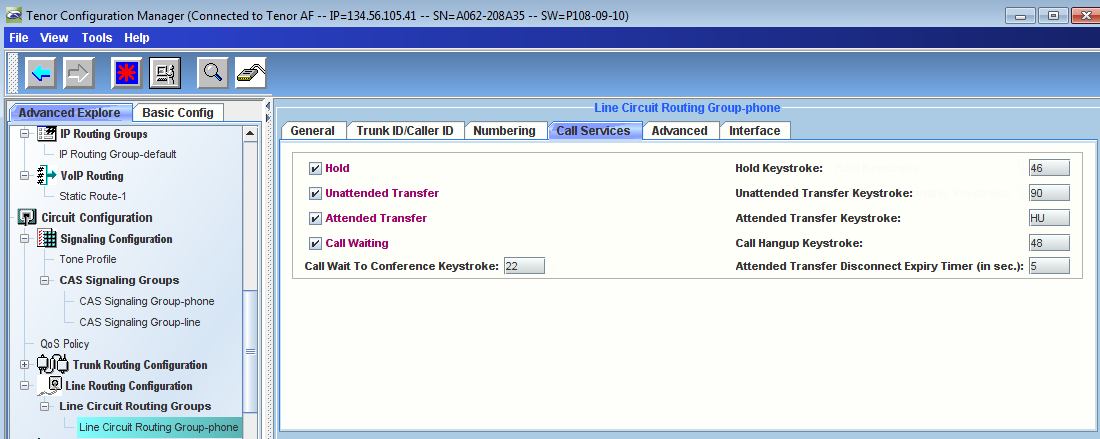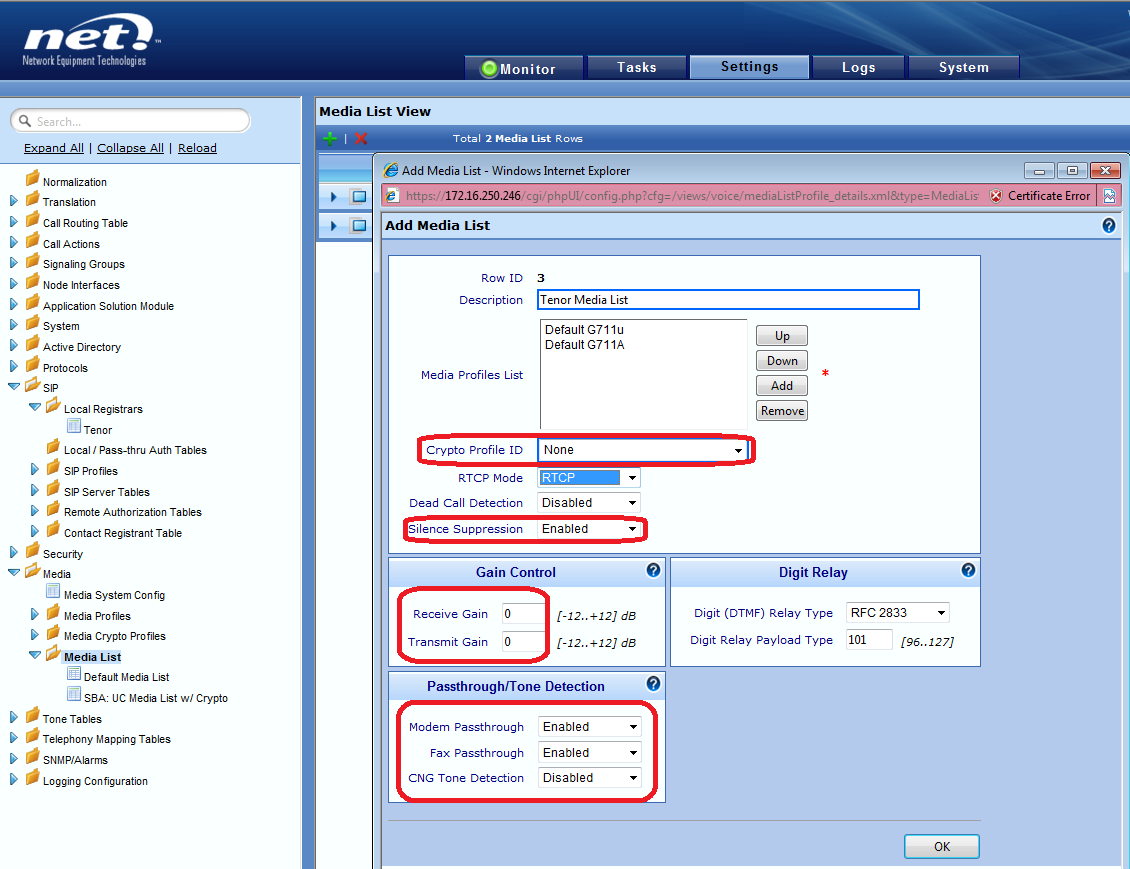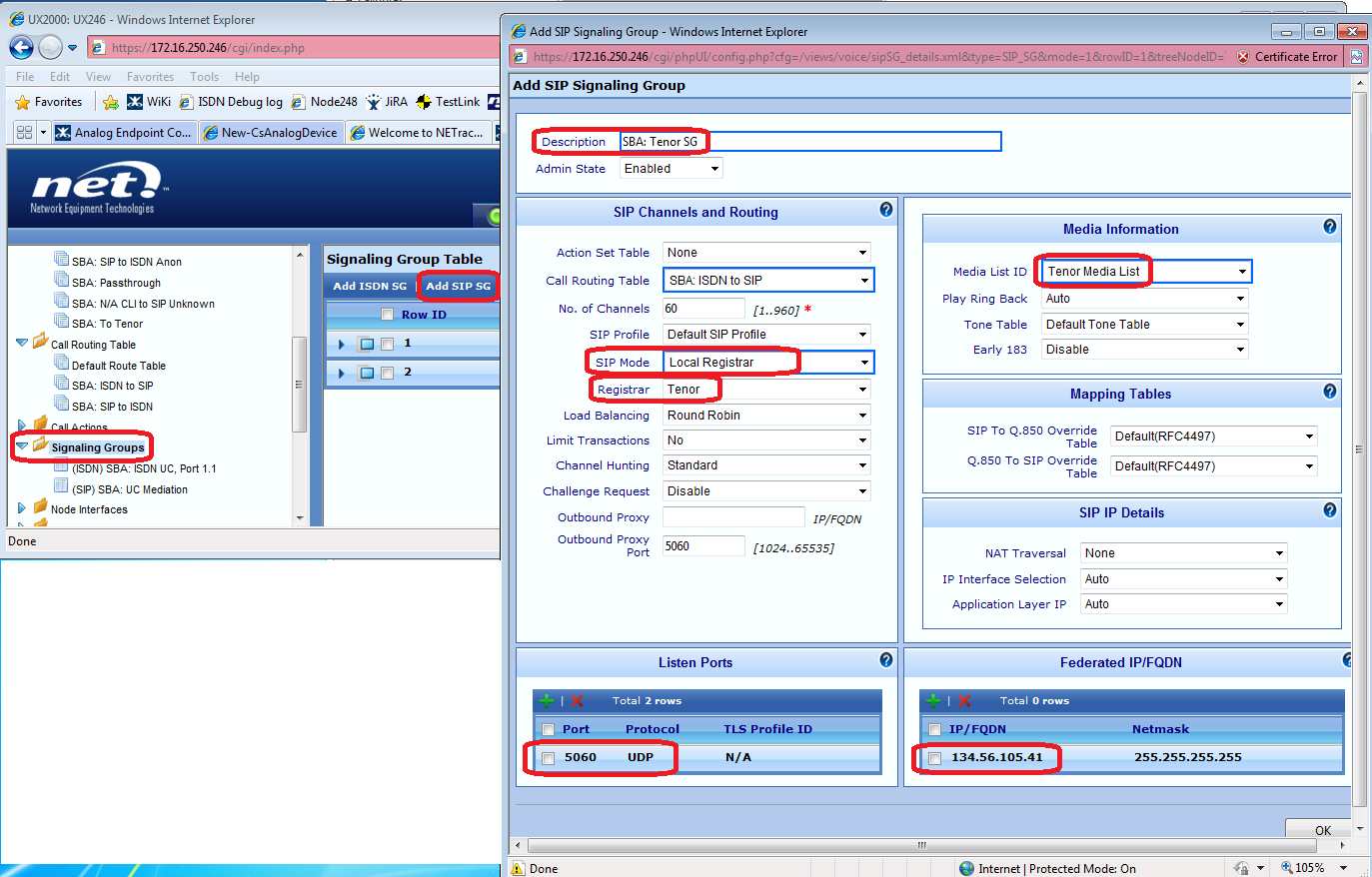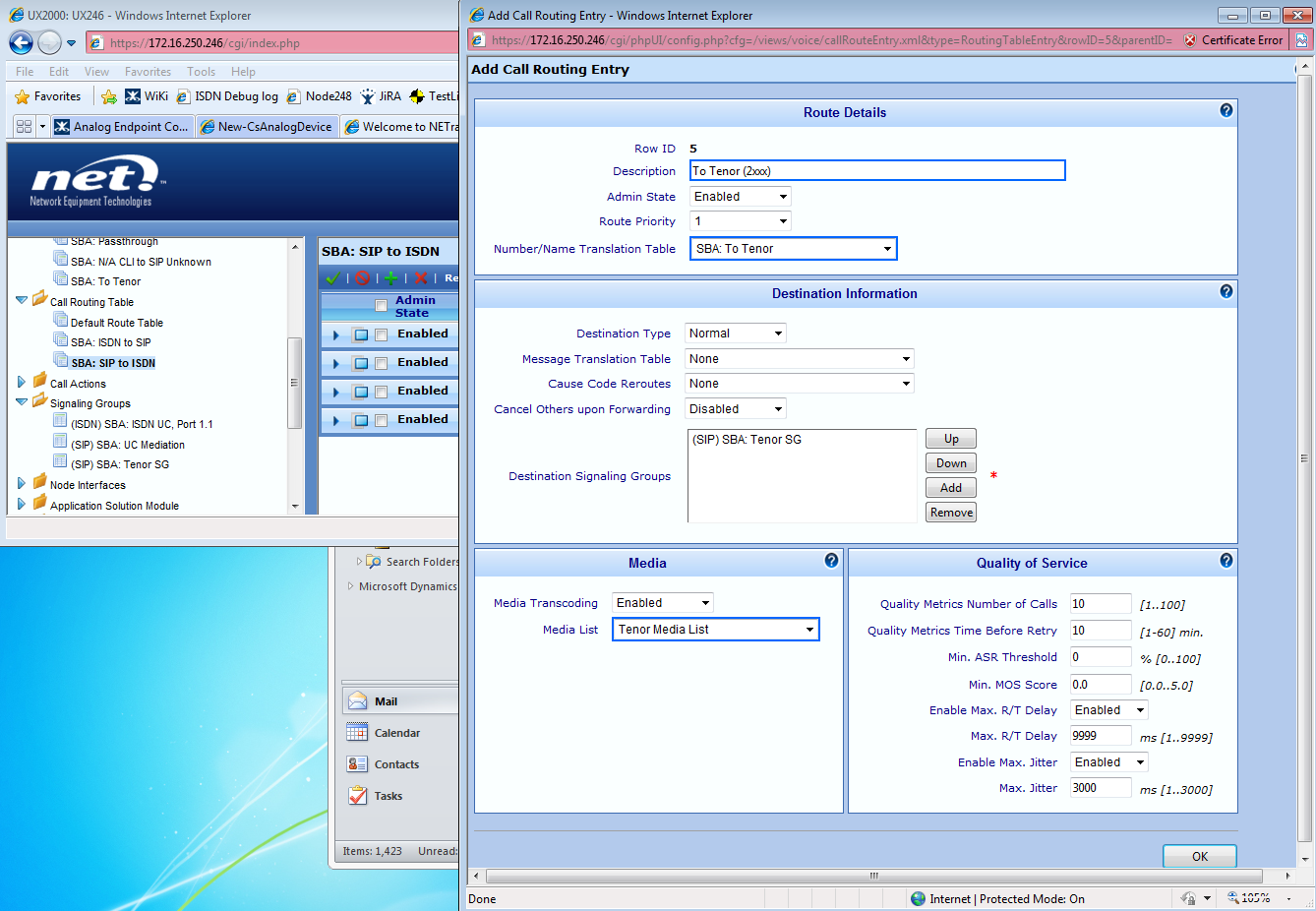Not supported by SBC SWe Lite in this release.
In this section:
The Tenor can be used to provide FXS analog capability to the
In this article, G.711 voice codec is used and CNG Tone Detection is disabled:
When CNG detection is disabled, theSBC lets the Calling fax machine on either side, ISDN or SIP, to send CNG. However, theSBC is actively listening for and detecting the Fax Answer message that the Answering fax machine sends because Fax pass-thru is enabled.
The following diagrams depict the signaling and media flow of the Analog End Point of LYNC in this deployment.
Outbound Fax call flow using Lync call control (signaling and media) |
|---|
Inbound Fax call flow using Lync call control (signaling and media) |
|---|
Related Information
In this deployment, following LYNC topology entities, PBX, and numbering plans are used:
FQDN |
IP Address |
Description |
|---|---|---|
uxdemo.net | 134.56.105.30 | LYNC SBA Domain |
rdc.uxdemo.net | 134.56.105.30 | DNS/AD/Ent. Root CA |
sba247.uxdemo.net | 134.56.105.247 | FQDN of Lync SBA Pool |
ux246.uxdemo.net | 134.56.105.246 | FQDN of the SBC GW |
Tenor AF | 134.56.105.41 | Analog Device |
Nortel Meridian | N/A | ISDN PBX |
LYNC SBA Users |
Line URI |
|---|---|
sip:SBAuser1@uxdemo.net | tel:+15102461001 |
sip:SBAuser2@uxdemo.net | tel:+15102461002 |
LYNC SBA ANALOG Users |
Line URI |
|---|---|
sip:ae11467d-d09d-4e78-ad2a-e4615b79ac57@Ribbon1000/2000DEMO.Ribbon (ANALOGph1) | tel:+15102462001 |
sip:80274280-9a22-43d9-b194-2640904c3e54@Ribbon SBC 1000/2000DEMO.Ribbon (ANALOGph2) | tel:+15102462002 |
sip:3f1e38d7-c8a3-425a-818c-bae3f2c28d62@Ribbon SBC 1000/2000DEMO.Ribbon (Fax1) | tel:+15102462003 |
Meridian Endpoints |
Extensions |
|---|---|
PBX Ph1 | ext: 6228 |
PBX Ph2 | ext: 6222 |
Before You Begin
The SBC SBA must already be configured. If not, configure and deploy the Lync SBA following the instructions in Preparing for SBA Deployment - First Steps.
Lync Configuration
Creating analog End Point using the New-CsAnalogDevice Command
Analog Endpoints must be created from the Lync Management Shell using the New-CsAnalogDevice cmdlet.
- On the Lync Server, go to Start > Microsoft Lync Server 2010 > Lync Server Management Shell.
Enter the command as shown below.
For Aanalog Phone Endpoints:
New-CsAnalogDevice \-LineUri tel:+15102462001 \-DisplayName "Analogph1" \-RegistrarPool cspool.uxdemo.net \-AnalogFax $false \-Gateway ux246.uxdemo.net \-OU "ou=Analog,dc=uxdemo,dc=net"
For Analog FAX Endpoints:
New-CsAnalogDevice \-LineUri tel:+15102462003 \-DisplayName "Fax1" \-RegistrarPool cspool.uxdemo.net \-AnalogFax $true \-Gateway ux246.uxdemo.net \-OU "ou=Analog,dc=uxdemo,dc=net"
Before running the commands above, make sure that the relevant Organizational Unit(OU) (in this example it is named Analog) exists in Active Directory. On a machine that can access the Active Directory Users and Computers snap-in, launch the Active Directory Users and Computers snap-in and verify that OU is present as shown in below screenshot:
Verify OU Is Present
- Launch the Lync Management Shell and run the relevant commands to create both Analog Phone and Analog Fax Endpoints as shown in below screenshot:
Launch Lync Management Shell
- Verify in Active Directory Users and Computers snap-in that relevant users are created successfully in Analog Organizational Unit as shown below:
Verify Users
Explanation of New-CsAnalogDevice
The New-CsAnalogDevice cmdlet instructs Lync to route calls from the analog device to the gateway specified in the -Gateway switch of the cmdlet; thus, ensuring that Fax calls will safely be transmitted over PSTN.
Tenor configuration
Requirements for Tenor
These instructions assume that:
- The Tenor gateway is running P108-09-10 or newer software release.
- The Tenor Configuration Manager is CM108-19-00 or newer.
Run the Tenor Wizard
- Launch the Quintum Configuration Manager and connect to your Tenor Device
- Upon connecting to the device, Configuration Wizard will run automatically
- Follow the Wizard Steps and enter the relevant IP addresses, Analog Endpoint numbers..etc. as shown below
Wizard Steps
- For this exercise we are using DHCP for the Tenor IP address configuration
IP Address Configuration - DHCP
- Enter the DNS IP address which is used in LYNC SBA Deployment Topology
IP Address Configuration - DNS
Enter DNS IP Address
- Verify that IP Address Configuration is completed as shown below
Verify IP Address Configuration
- Continue the wizard steps for Dial Plan Configuration
Dial Plan Country
Progress Tone Country
- Verify that Dial Plan Configuration is completed as shown below
Verify Dial Plan Configuration
- Continue the wizard steps for Phone Port Configuration
Phone Port Configuration
- Enter the relevant Phone Number/Extension (in this example we are using 2001 and 2002 users for the Analog phone endpoints)
Enter Phone Number/Extension - 2001
Enter Phone Number/Extension - 2002
- Click "Save/OK" and then the "Done" buttons
Add Phone Number/Extension
Configured Phone Number/Extension
- Verify that Phone Port Configuration is completed as shown below
Verify Phone Port Configuration
- Continue the wizard steps for Multi Path Configuration
Enable Pass Through Calls
Add Bypass Number
Add Next Bypass Number
Configure Bypass Number
- Verify that Multi Path Configuration is completed as shown below
Verify Multi Path Configuration
- Continue the wizard steps for Line Port Configuration
Line Port Configuration
- Verify that Line Port Configuration is completed as shown below
Verify Line Port Configuration
- Continue the wizard steps for VoIP Routing Configuration
VoIP Routing Configuration
- Enter the SBC 2000 Gateway IP address in the Primary SIP Server IP/Domain Name field and the relevant Port (5060 in this case)
Enter IP Address
- Enter the SIP user information for the related 2001 and 2002 users
Enter SIP User Information - 2001
Enter SIP User Information - 2002
SIP User Configuration
- Verify that VoIP Routing Configuration is completed as shown below
Verify VoIP Routing Configuration
- Continue the wizard steps for Idle Channel Configuration
Idle Channel Configuration
- Verify that Idle Channel Configuration is completed as shown below
Verify Idle Channel Configuration
- Click the Accept button on Configuration Summary to complete the wizard run
Complete Wizard Run
- Click OK to restart the Tenor device as shown below
Restart Tenor Device
Additional Post-wizard Settings and Configuration Verification
Verifying the SIP Signaling Group Options
- Reconnect to Tenor Device using the Configuration Manager and Verify that SIP Signaling Group is configured In General Tab as shown below
Reconnect to Tenor Device
- Verify that SIP Signaling Group is configured in Advanced Tab as shown below
The Transport Type must be set to UDP.
Verify SIP Signaling Group Is Configured
Verify that the Silence Suppression parameter in the IP Routing Group is disabled
Disable Silence Suppression
Verify the Tx/Rx Gain Values in the CAS Signaling Groups
Verify the following settings in Tenor:
CAS Signaling Group | Rx Gain | Tx Gain |
|---|---|---|
CAS Signaling Group - Phone: | -6 | 0 |
CAS Signaling Group - Line: | 6 | 0 |
- Verify Tx/Rx gain values in the CAS signaling groups - Phone
CAS Signaling Group - Phone
- Verify Tx/Rx gain values in the CAS signaling groups - Line
CAS Signaling Group - Line
Creating a Route For Calls From Tenor to Lync
- In Configuration Manager, right click on Number Tables in left pane and select New as shown below
Create New Number Table
- Create a new Number Tables to allow Analog Endpoints to be able to make calls to LYNC endpoints as wells as to PBX endpoints as shown below
Enter Number Table Information
- Create an entry in the Routing Table as shown below
Routing Table Entry
- Modify the default Number Table to allow incoming calls to Tenor Device as shown below
Modify Default Number Table
- Verify that "Use Routing Table" option is selected in Gateway configuration field as shown below
Select Use Routing Table
Verifying Codec Selection
Ensure that the codec settings are identical with the matching codec in SBC.
Use only G.711U and/or G.711A.
- Verify that Voice Codec settings are configured correctly as shown below
Verify Voice Codec - 1
Verify Voice Codec - 2
Verify Supplementary Services Enabled
Tenor supports the following supplementary services - Hold/Unhold, Unattended (Blind) Transfer, and Attended (Consultative) Transfer. These features can be enabled and configured using either a Line Circuit Routing Group (LCRG) or Trunk Circuit Routing Group (TCRG). Follow the configuration steps below:
- Verify that "Detect Flash Hook Signal" option is selected in CAS Signaling Group-phone > Signaling Tab
Select Detect Flash Hook Signal
- Verify that "Generate Flash Hook Signal" option is selected in CAS Signaling Group-line > Signaling Tab
Select Generate Flash Hook Signal
- Verify that Call Services are selected in Line Circuit Routing Group-phone > Call Services Tab
Select Call Services
Change Fax Relay from T.38 without Fallback to G.711
Make sure that Fax Relay is set to G.711.
The codec should be either G.711U or G.711A depending on your particular environment.
- Enable both, Fax Relay and Fax Modem Coding:
- Fax Relay: This command configures how the Tenor signals the other end to tell the peer how to switch over to the correct protocol for a fax call. When FaxRelay is set to anything other than 0, there will be a short delay in training as the Tenor determines whether the device at the other end is a fax machine or a modem
- Fax Modem Coding: Enable the Fax Modem Coding configuration option if the Tenor will be used to make modem calls (remote door/elevator control).
When the Tenor is configured for modem over IP calls, FaxModemCoding allows you to select which codec will be used.
When FaxRelay is set to 0 (Disabled), Modem over IP (MoIP) takes over, and all fax calls will be sent as MoIP passthrough with the codec specified by the FaxModemCoding setting.
When FaxRelay is set to anything other than 0, there will be a short delay in training as the Tenor determines whether the device at the other end is a fax machine or a modem.
Change Fax Relay
Configuring the Relay of Calling Name (CNAM)
The configuration of the Calling Name (CNAM) is optional. Tenor can relay CNAM in both directions Analog to SIP and SIP to Analog.
Relay of Calling Name
| Analog to SIP | SIP to Analog |
|---|---|---|
Not send CNAM |
|
|
Send the CNAM | Send the CNAM of each analog line as configured in the DN Channel Map:
| Send the CNAM from the SIP call leg. |
Send default CNAM | Send a default CNAM for all calls regardless of the Calling Name of the originating channel. | Send a default CNAM for all calls regardless of the Calling Name of the originating channel. |
Sample Tenor AF Configuration File - P108-09-10
Sample Tenor AF Configuration File - P107-09-10
Ribbon SBC 1000/2000 configuration
Requirements and Prerequisites
- This document assumes thatSBC Lync 2010 wizard was ran prior to the configuration
- Running the Lync 2010 wizard will ensure SRTP towards Lync is set to Required
- Media bypass must be enabled in Lync
SIP Registrar Table
- Browse toSBC 2000 WebUI > Settings Tab > SIP / Local Registrars (in left pane)
- Click on Add
button and add a SIP Local Registrar Entry as shown below
Add SIP Local Registrar Entry
Media List Configuration
- Browse to SBC 2000 WebUI > Settings Tab > Media List (in left pane)
- Click on Add
button and add a Media List Entry as shown below
Make sure to have following settings are configured in Tenor Media List:
CNG | Disabled |
Fax passthru | Enabled |
Modem Passthru | Enabled |
Silence Suppression | Enabled |
Rx/Tx Gain | 0 |
Add Media List
Translation Table
- Browse to SBC 2000 WebUI > Settings Tab > Translation (in left pane)
- Click on Add
button and add a Translation Table with following entry as shown below
Add Translation Table
Signaling Group (uses UDP only)
- Browse to SBC 2000 WebUI > Settings Tab > Signaling Groups (in left pane)
- Click on Add SIP SG button and add a SIP Signaling Group for Tenor Device connectivity as shown below
Add SIP Signaling Group
Call Routing Table
- Browse to SBC 2000 WebUI > Settings Tab > Call Routing Table (in left pane)
- Click on SIP to ISDN Call Route Table and hit Add
button to add an entry to route calls to Tenor (for those with 2xxx extension in this example)
Add Entry to Route Calls
- Re-sequence the Call Route entries in this table to make sure that calls to 2xxx extensions (Analog Endpoints) will use the entry that you just created in previous step
Re-sequence Call Route Entry
Troubleshooting Techniques
Troubleshooting FAX Calls Between the Tenor and PSTN
- If you are getting comm errors on the Fax machine, check the following resources for solutions:
- comm error 350 - disable ECM
- error codes 242,346,321,344,388,283 - The first 2 settings you want to change are the error correction (ECM) and v.34 these are on by default you would want these off.
If faxes are failing, check the E1 port counters for slips and frame errors.
- The frame errors and the slips counters must not be increasing. You can check if they are increasing by resetting the counters. If the errors are increasing, the issue could be caused by one of the following:
- System timing / clocking. Check the clock source (System -> System Timing) - it should be set to Network/T1/E1 port and not System/Free run. If the clock source is set to Network, but the Current Active Clock shows as Free run, click Apply and ensure that Current Active Clock is now set to Primary. This should resolve the clocking issue as long as the error counters do not increase.
- If the Tenor is not configured to register with the SBC local SIP registrar and the SIP Signaling group in SBC constantly goes down, check the contents of the var_config.cfg file (from Tenor Config Manager -> Tools -> Var_config -> Edit) and delete the line specifying the transport protocol as in P108 it is obsolete.
- Bad E1 cable. Replace the cable.
- Faulty RJ45 jacks. Replace the cable or fix the Rj45 jacks.
- Faulty RJ45 socket. Try configuring a different T1/E1 port. Visually check the pins in the E1/T1 ports for any differences.


